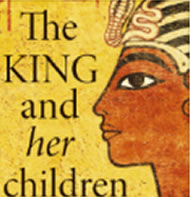The Pharaoh's Daughter And The Chiswick Connection
Annette Duckworth believes she has found a missing link in Egyptian history
|
The story of how Hatchepsut, the woman known as the Pharaoh's daughter, came to adopt an abandoned infant, rule Egypt for 22 years, before being spurned and her reputation destroyed after her death, has captivated a local resident so much that she has written a book, The King And Her Children.

Annette Duckworth
Grove Park resident Annette Duckworth, who is well known for her articles on bees and her homemade soaps, was on holidays in Egypt over five years ago when she became interested in the story of Hatchepsut.
"There is so much recorded in Egypt but I thought there was something missing, so I came home and did some research. I came up with a thesis, which I reveal in the book. So there is a mystery element to the book but it is really the story of Hatchepsut."
Why is Hatchepsut so compelling? Annette says; "She finds and adopts an abandoned infant when she herself is still a child and does not understand the enormity of her action. By rescuing this child, Hatchepsut finds love in an otherwise loveless existence. He, Senenmut, becomes the core of her life and watching him grow into a man of extraordinary ability, makes her audacious.
"Her ambition for him drives her to seize the throne so she can raise him also, to rule the proudest Empire on earth.
"Hatchepsut and Senenmut are well known figures in Egyptian history, and while it has fallen to me to paint the story of their lives where it has been lost, these are people who once lived and breathed.
"The thing about Hatchepsut is that Egyptologists
do not understand what happened to her.
She took the throne after her husband’s death when her stepson, Tutmose
lll, her husband’s child by a harem woman, became Pharaoh. She had been
Regent, as he was only a young child. As Regent she would have held all
the power until Tutmose came of age in about 12 years’ time, so Egyptologists
wonder why she bothered to make herself Pharaoh."
Hatchepsut reigned for 22 successful years and after her death Tutmose reigned alone for around 30 years until his son, Amenhotep ll. became joint Pharaoh with him.
All was sunny, until about 30 years, or more, after Hatchepsut’s death, suddenly those in power turned against her memory. They dragged her statues out of her Mortuary Temple at Deir el Bahri, smashed them, dug a pit and buried them. Most of the wall paintings, in all parts of Egypt depicting Hatchepsut, had her image cut out and her cartouches removed.
Many monuments with her name on them had this changed to either her father’s name or her husband’s name, and never was she mentioned in any of the King lists.
Annette comments; "This ferocious annihilation of her name is almost unique in Egyptian history. Only the great heretic Pharaoh Akenaten had similar treatment. And it is not because she is a woman, because other women, admittedly few, reigned as Pharaoh and were valued for what they did."

So there is a mystery.
"There is also a mystery about the man Senenmut. Joyce Tyldesley, one of the foremost authorities on Hatchepsut’s reign, in her book entitled ‘Hatchepsut’, describes him as the ‘Greatest of the Great.’ But he is known to be from humble origins. We have the names of his birth parents, and they have no titles or rank, and yet he is highly educated, a privilege only open to the top 5% of society. He is given many many titles. We see statues of him holding the young Princess Nepherure, a thing forbidden for anyone not of royal blood. We see statues of him worshipping the gods, in many guises, statues which would have been placed in the presence of the gods, again a thing forbidden to those not of royal blood.
"So he is an enigma. He has 2 tombs built but is never buried in
either of them. He just disappears from the history of Egypt. His first
tomb is described in the book ‘Hatchepsut, from Queen to Pharaoh’, (produced
by the Metropolitan Museum in the US) as being clearly decorated by the
Royal workshops, and his unused sarcophagus is made of quartzite, a stone
forbidden to anyone who was not royal.
"His second tomb is situated under the court of Hatchepsut’s Mortuary temple at Deir el Bahri. This is a sacred area, and so it is extraordinary that his tomb is situated there. There are carvings of him on the walls of the holiest shrine, the shrine of Amun, at Deir el Bahri, an extraordinary thing for a non-royal. There is clearly a very close bond between Hatchepsut and this man."
So how can all these contradictions exist together? Some have suggested that Senenmut must have been Hatchepsut’s lover, but this has been dismissed by the eminent Egyptologist Peter Dorman, who has made a special study of Senenmut’s monuments.
But there is one explanation which answers all these questions, and it is the purpose of Annette's book to put this forward as the plausible and fascinating answer to these mysteries.
After her five years of research she said: "Slowly it became probable that my thesis was correct and I said to myself "It has to be written". Interestingly I have found two other people who discovered the same thing."
Annette has lived in Chiswick 34 years in Grove Park with her husband where they raised their three sons, who now grown up. She worked as a physiotherapist at Chelsea and Westminster hospital and this is her first book. Her son has designed the cover.
Mirador is publishing the book and it is available on Amazon in the next few weeks.
And having been bitten by the writing bug, Annette says she is now thinking of her next one.
"The book ends on a cliff edge so I am now thinking of the sequel."
November 5, 2018